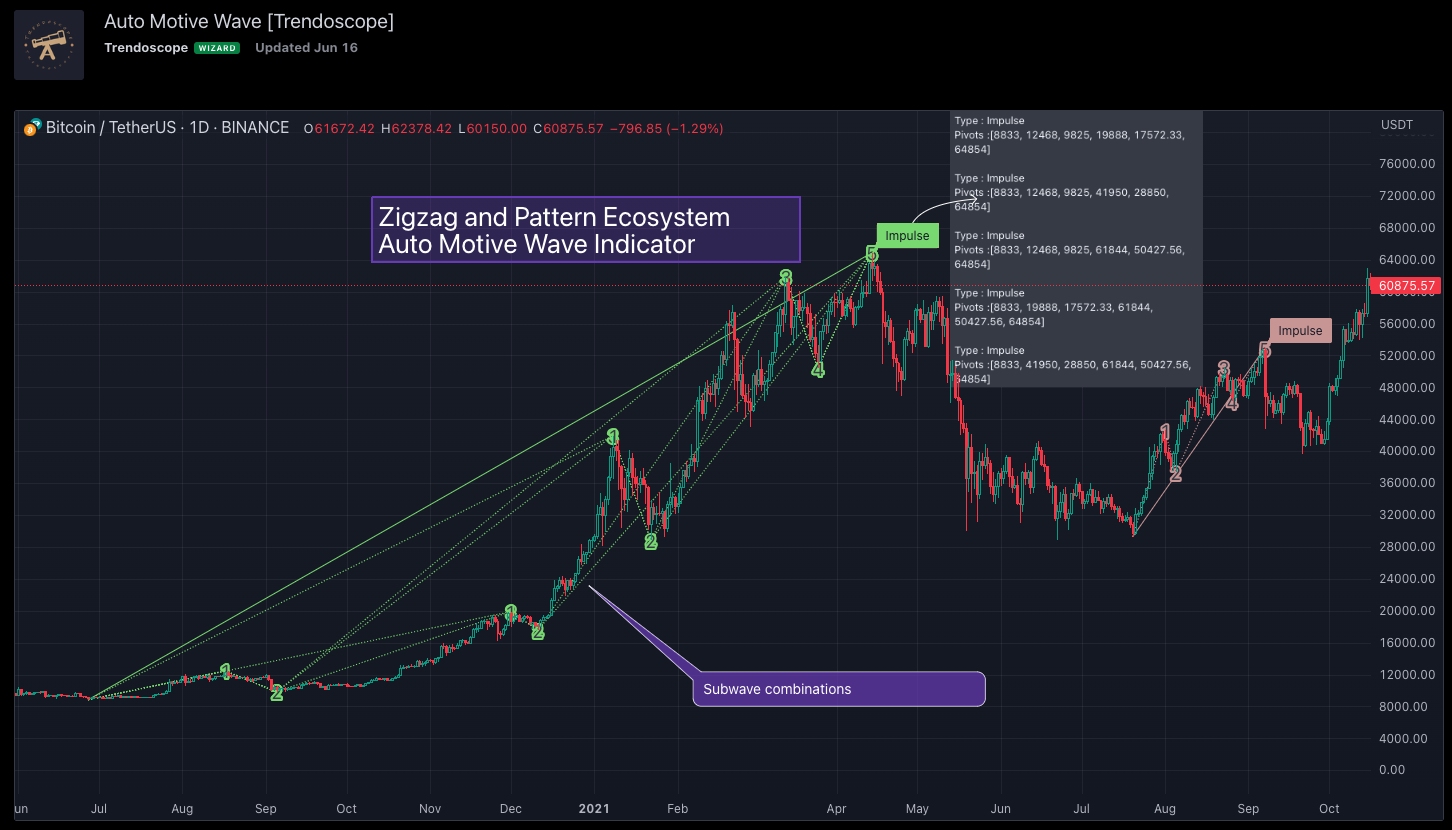Motive Wave Finder for Elliott Wave Analysis

Motive Wave Finder is an innovative technical indicator that automatically scans the markets for possible motive waves (Impulse Waves and Diagonal Waves) and draws them on the charts with the complete sub-wave breakdown.
Link to the Indicator: Motive Wave Finder
How did it start?
Earlier we created an interactive script to study Motive Waves by manually selecting the wave patterns on the chart.
You can find the details of the open-source script here: Interactive Motive Wave finder
While this indicator works based on interactive input and lets users select the pivots for scanning the valid motive waves, in the new indicator we do this automatically. Hence, you no longer need to draw the waves manually to check. The indicator will do it for you.
Conditions for Motive Wave
Rules for Motive Waves remain the same as before. Motive waves can be either Impulse or Diagonal Waves. Diagonal waves can be either expanding or contracting diagonals. To learn more about diagonal waves, please go through this article - Decoding Wedge Patterns.
Rules for generic motive waves are as below
- Pivots in order - Should consist of 5 alternating waves. (Swing High followed by Swing low and vice versa)
- Directions in order - This can start from Swing High and end in Swing High or start from Swing Low and end in Swing Low of a zigzag.
- Wave-2 should not move beyond Wave-1. This means, the Wave-2 is always shorter than Wave-1 with respect to distance between the price of start and end and Wave 2 retracement is less than 100% of wave1
- Wave-3 always moves beyond Wave-1. This means, the Wave-3 is always longer than Wave-2 in terms of price and Wave 3 retracement is more than 100% of wave2
- Wave 3 is never the shortest one - Among Wave-1, Wave-3, and Wave-5, Wave-3 is never the shortest one. This means, either Wave-1 or Wave-5 can be longer than Wave-3 but not both. Wave-3 can also be longest among the three.
Here is the pictorial representation of the rules of the Motive Waves
Rules for Impulse Waves
- Wave 4 never moves beyond the end of Wave 1 - meaning Wave 1 and Wave 4 never overlap on the price scale.
- Wave-1, Wave-3 and Wave-5 should not be either expanding or contracting. Meaning, we cannot have Wave-1 > Wave-3 > Wave-5, and we cannot have Wave-1 < Wave-3 < Wave-5
Pictorial representation of the impulse wave rules are as below:
Rules for Diagonal Waves
- Wave4 never moves beyond the start of Wave 3 - Wave 4 retracement is less than 100%
- Wave 4 always ends within the price territory of Wave 1 - Unlike impulse wave, wave 4 intersects with wave 1 in case of diagonal waves. This is the major difference between impulse and diagonal waves.
- Waves are progressively expanding or contracting - Wave1 > Wave3 > Wave5 and Wave2 > Wave4 to be contracting diagonal. Wave1 < Wave3 < Wave5 and Wave2 < Wave4 to be expanding diagonal waves.
Pictorial representation of the Contracting Diagonal Wave is as below. Here, the Wave-1, Wave-3 and Wave-5 are in contracting formation.
Pictorial representation of the Expanding Diagonal Wave is as below. Here, the Wave-1, Wave-3 and Wave-5 are in expanding formation.
Indicator Settings - Motive Wave Finder
Input settings allow users to calibrate the indicator to match their trading style and preferences. This includes
- Theme: Background theme of the chart. Based on the settings line and label colours are generated to match that of the background.
- Zigzag Length and Depth: This is the length of level 0 zigzag and the depth to keep the historical pivots. Depth also plays a role in scanning the recursive level zigzags. The higher the depth, the more levels are calculated - but this also means the indicator will behave slower and may even time out.
- Filter Level: Scanning can only be done on certain levels or above a certain zigzag level. Level 0 does not have any sub-waves. Hence, it is not possible to scan the waves on level 0 zigzags.
- Draw only the first sub-wave: If selected, only the first valid sub-wave is drawn on the chart. Otherwise, all the possible sub-wave patterns will be shown. This can look messy on the chart if there are too many combinations.
- Repaint: Repainting allows a scanned motive wave to update based on the latest changes in the pivots. If repaint is selected, then the indicator can only scan either motive or diagonal waves. If the repaint option is unselected, then the scanning is done only based on the confirmed pivots. This allows the algorithm to scan both impulse and diagonal waves.

Comments